Castles in Italy from Rome to the island of Ischia, you can visit today
The history of Italy goes way back and is therefore very rich in archaeological sites and Etruscan, Roman and Romanesque buildings, as well as many other eras. Thanks to intelligent renovation and dedicated reconstruction, some of them have become historic homes. The castles are now exclusive places for fascinating and exciting holidays.
Spending holidays in a castle is a magical experience. Sleeping, where kings once resided, in castles and mansions throughout Italy, where their historic charm, style and charm make Italian history and culture a very personal and vibrant experience.
Spend a holiday or a weekend in a castle, enter a “world of dreams”, stop the daily frantic pace and go back in time to discover ancient traditions, artistic architecture, interiors with antiques, paintings and tapestries the most precious ones. These castles today offer the most modern comfort for relaxation, sport and health. A romantic getaway, a return to the past, a discovery of medieval Italy, holidays like no other.
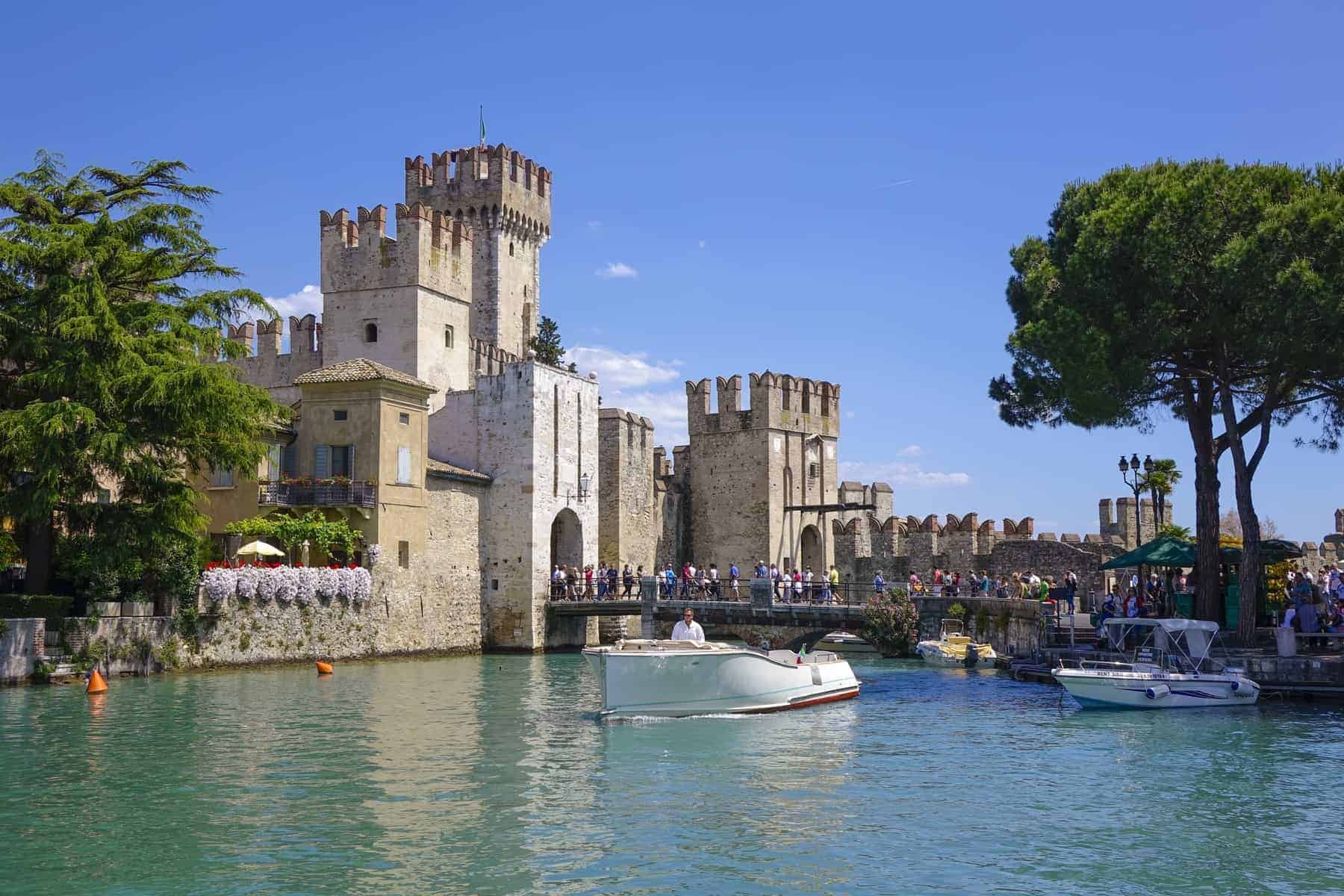
Castello Scaligero in Sirmione on Lake Garda, Lombardy, Italy, Europe
Castello Scaligero in Sirmione on Lake Garda
The Scaligero Castle is a fortress from the Scaliger era, access point to the historical center of Sirmione. It’s one of the most complete and well-conserved of Italy’s castles. Still owned by the Scaliger family. The Scaligero Castle is the only point of access to the historical center of Sirmione. It is one of the most complete and best-preserved castles in Italy, as well as a rare example of lake fortification. Entering the castle is mandatory (there is no other entrance) passing the drawbridge, the fortress is in fact lined on all sides by Lake Garda. The castle is bathed on all sides by the waters of Lake Garda, and on one of these sides the dock was made, shortly after the construction of the castle, which was once a place of refuge of the fleet of Verona. The walls and the three massive main towers are characterized by the dovetailed battlements that distinguish each Scaligeri construction.

Scaligero castle lake Garda, Italy
Behind the three towers emerges the imposing tower, 47 meters high, under which are the cells where prisoners were held. Through doors fitted with effective locking systems, you enter the large porch, inside which stands a staircase leading to a drawbridge. From there, up a flight of 146 steps, you can reach the wall battlements, from which you can enjoy the dock. The construction of the fortress began in the mid-thirteenth century, possibly on the ruins of a Roman fort. Its construction was ordered by the mayor of Verona, Mastino I della Scala. The function of the castle was one of defense and port control, as the town of Sirmione, being in a border location, was more exposed to attacks. About a century later, two courtyards and a detached fortification were added. In 1405, Sirmione came under the control of the Venetian Republic which began work to strengthen the defensive structures. It was at this time that the dock was made which you can see today. Within the large interior portico of the castle, a Roman and medieval Lapidarium was set up as well as a brief exhibition in which some of the panels display the most important information about the fortress.

Castel Sant’Angelo
The history of Castel Sant’Angelo is as complex as the multi-level edifice of the castle itself. The walls have seen more than 1800 years of blood, wars and deaths. It was built between 123 and 139 AD to serve as a mausoleum for the Roman Emperor Hadrian and his family. Legend has it that the name of the castle was given after the Archangel Michael appeared at the top of the castle carrying his sword and thus ending the plague of 590 which tormented Rome. You can see an imposing statue of the Angel at the top of the castle. In the 14th century, Castel Sant’Angelo assumed the role of a military fortress connected to the Vatican by an elevated passage that still exists, the “Passetto di Borgo”. It was then used as a prison. A place where executions took place and prisoners were left hungry. In 1901, it became a wonderfully rich museum that housed remnants of its tumultuous past. Today, it adorns the Roman horizon with its golden lights and is visited by many visitors during their stay in Rome.
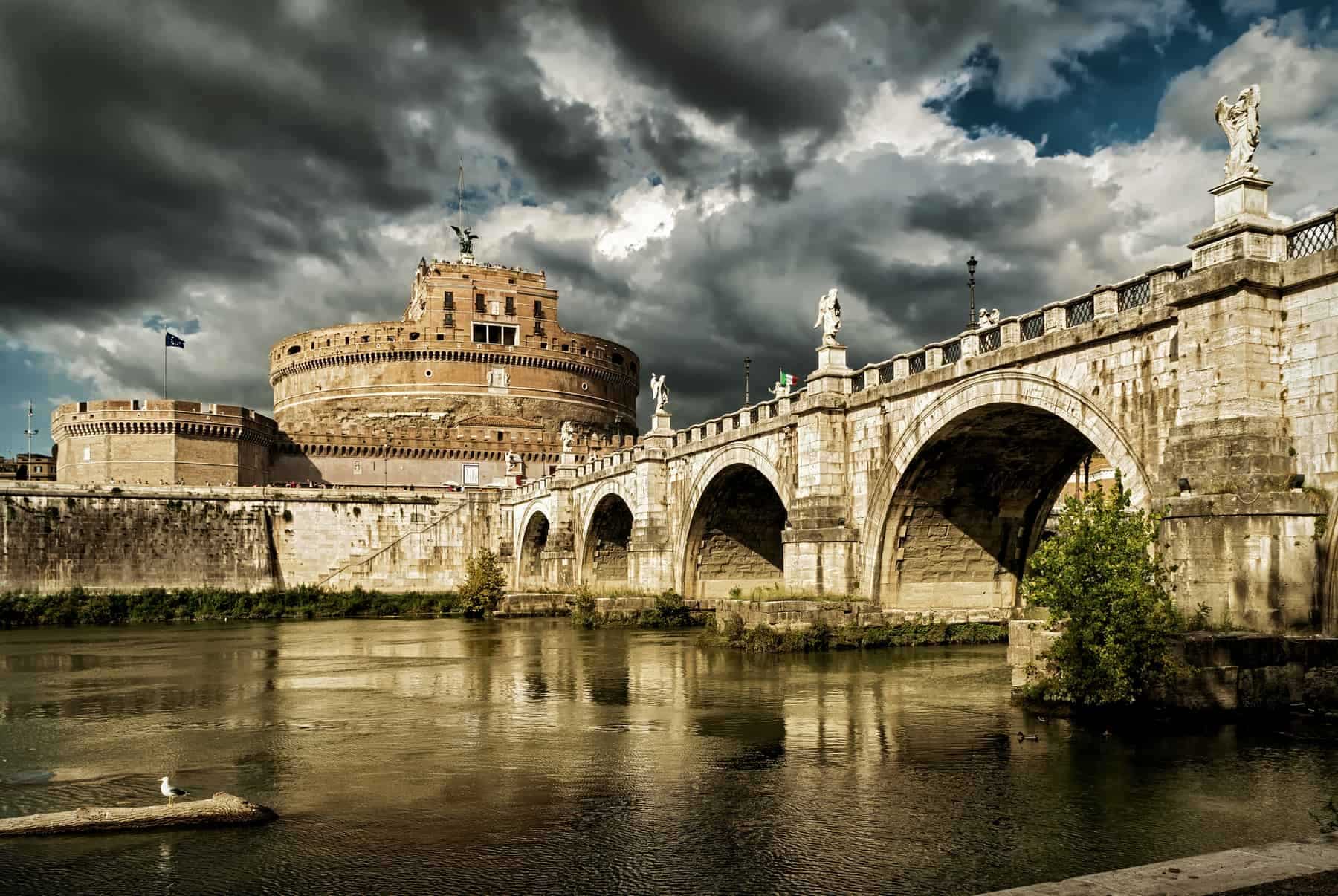
Castel Sant’Angelo (Castle of Holy Angel), Rome
A mausoleum, a fortress, a refuge, a museum … The way a castle has assumed such a myriad of roles throughout its life remains a subject of fascination, till nowadays. Rome is full of monuments and sites rich in history, stories and legends, but Castel Sant’Angelo is one that truly captures the very essence of the transformation of the city over the centuries. Each visitor experiences his visit differently; some will be amazed by his treasures, while others will be frightened by the number of lives lost in battle in one place. Whatever the experience, it’s a life worth living.
One of the attraction you will find in Castel Sant’Angelo is the National Museum of Castel Sant’Angelo and its eclectic collection of paintings, sculptures, military memorabilia and medieval firearms.
The castle has five floors starting with a sinuous ramp of Roman construction. The second floor contains prison cells and a torture chamber, the third floor has courtyards and a chapel, the fourth floor houses papal apartments and the fifth floor houses the treasure and the library.
At the top is a huge terrace, as well as a cafe, with magnificent views of Rome and the Vatican City. If you arrive early for lunch, you may be able to hang a table with a magnificent view of St. Peter’s Basilica.
The Sant’Angelo Bridge is one of the most beautiful Roman bridges still alive. Emperor Adrian built it to connect Campo Marzio to his mausoleum. It dates from the year 135
In the 16th century, Pope Clement VII placed statues of Saints Peter and Paul at the end of the bridge. In 1688, 10 angel statues designed by Gian Lorenzo Bernini were mounted on the parapets.
Bernini himself carved the figures of the Angel wearing the crown of thorns and the Angel carrying the cartouche INRI (1668-71). When the pope saw them, he found them too beautiful to be exposed to the elements.
The two statues were finally placed in the church of Sant’Andrea delle Fratte, where you can still see them, while the assistants of Bernini have refurbished the two statues that are still exposed on the Ponte S. Angelo instead original ones.
To visit Castel Sant’Angelo is a good thing. Castel Sant’Angelo is a place that contains stories that deserve to be known and that give a glimpse of the Eternal City that other monuments might not give. The lavishly decorated papal apartments are worth the trip, and you will not regret paying the price of the entrance ticket when you leave the castle and gasp in front of the view of Rome at sunset.
The Castel Sant’Angelo, a historical monument in Rome, is easily recognizable by its unique shape and the beloved statue of Archangel Michael towering above the rooftop terrace. The castle is located close enough to the Vatican City and just opposite the Sant’Angleo bridge (Castel St. Angelo bridge). The bridge, reserved for pedestrians, is one of the most famous in Rome and was built in 239 AD.
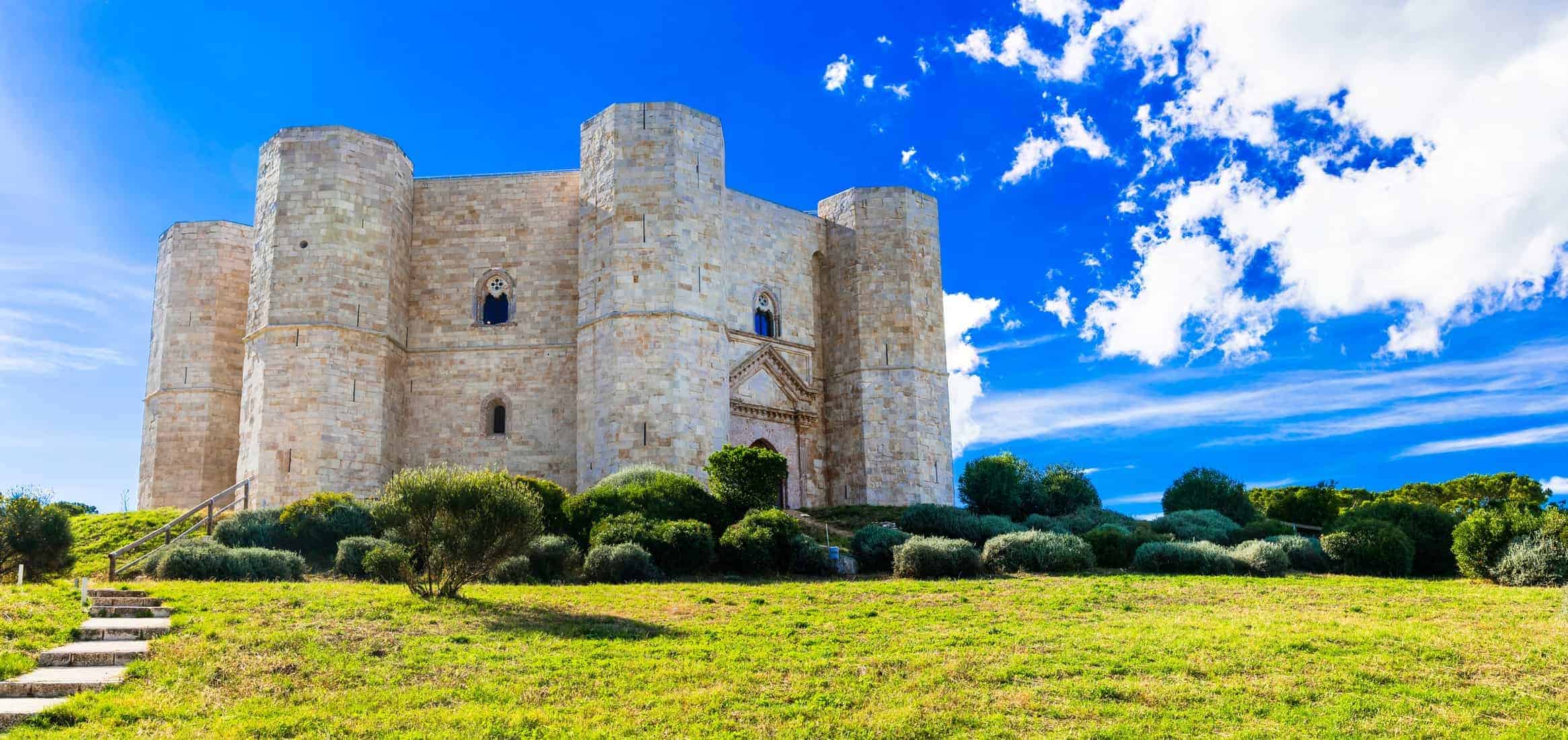
Unique octagonal castle Castel del Monte, Puglia, Italy.
Castel del Monte
From a distance this 24 meters’ tall castle gives an eerie impression and wouldn’t look out of place in a dramatic mystery film, particularly when there’s lightning in the sky. Not least of all because of its splendid colors. Built from local limestone from different parts of the region, the castle can look anything from a greyish white to rose tinted depending on the time of day and weather.
The medieval castle built in 1240 is quite possibly the most famous in Puglia offering the visitor a unique and diverse sense of history. It is a proud 1000 meters round and is one of many castles built in Puglia by Emperor Federick II. Records indicate that during 1246 it was used as a prison, but a mere 3 years later, was the location of a marriage celebration between the emperor’s illegitimate daughter Violante and the Count of Caserta. In 1326 it was host to another wedding, this time to that of Hubert de la Tour, Dauphin of France, and Maria del Balzo. This conflicting use of the castle, from a prison to weddings, doesn’t end there however. Centuries later during the 1656 plague, it was a shelter to noble families of nearby towns and then from the 18th century it was rather tragically left deserted to become a ruin. Although there is no evidence to suggest how the castle was used between these periods, some of the rooms appear to have been planned as bathrooms, bedrooms and service rooms, perhaps for Federick II himself.
Thanks to the Italian State who took responsibility for a restoration project, the Castle Del Monte has long been brought back to life and now attracts a staggering 150,000 visitors a year. Once inside the castle, with its intricate and elaborate architecture, its uniqueness becomes evident. It is for this reason that in 1996, UNESCO included the castle on its world heritage list meeting the criteria of being a monument of universal value. The interior has a grand mix of Gothic, Romanesque and Classic architecture as well as columns of limestone breccia. The allure doesn’t end there. Taking a look around, as the story of the castle unfolds, you realize that there is a significant use of the number 8. There are 8 rooms on the ground floor each of trapezoidal shape that are situated around an octagonal courtyard. At each corner there are 8 towers also octagonal in shape. With this in mind, it’s easy to get confused about the parts of the castle you have already seen. But once you have your bearings again, the spiral stoned staircase that leads up to the first floor has large French windows that illuminates the room providing a scenic view over the surrounding and vast countryside.
It is the repeated use of the number 8 that leads to another theory of the castle’s purpose; that having been built as an octagonal, it either has a mathematical symbolism, or that octagons represent eternal life. As spiritual as these theories may be, no one can doubt the powerful presence of the Castel Del Monte.
It’s not only the architecture and varied history that provides plenty of discussion amongst its visitors. So do the rumors of ghostly sightings and noises. When approaching members of staff about such whispers that I’d read in an Italian magazine, they laughed nervously before admitting that there is some truth in the rumors. “Once the castle is closed to the public each day, some employees have said that they’ve heard footsteps coming from the floor above when there can’t possibly be anyone there,” explained a tour guide. It is also claimed that these footsteps can only be heard on the 17th of each month, the unlucky date in Italy.
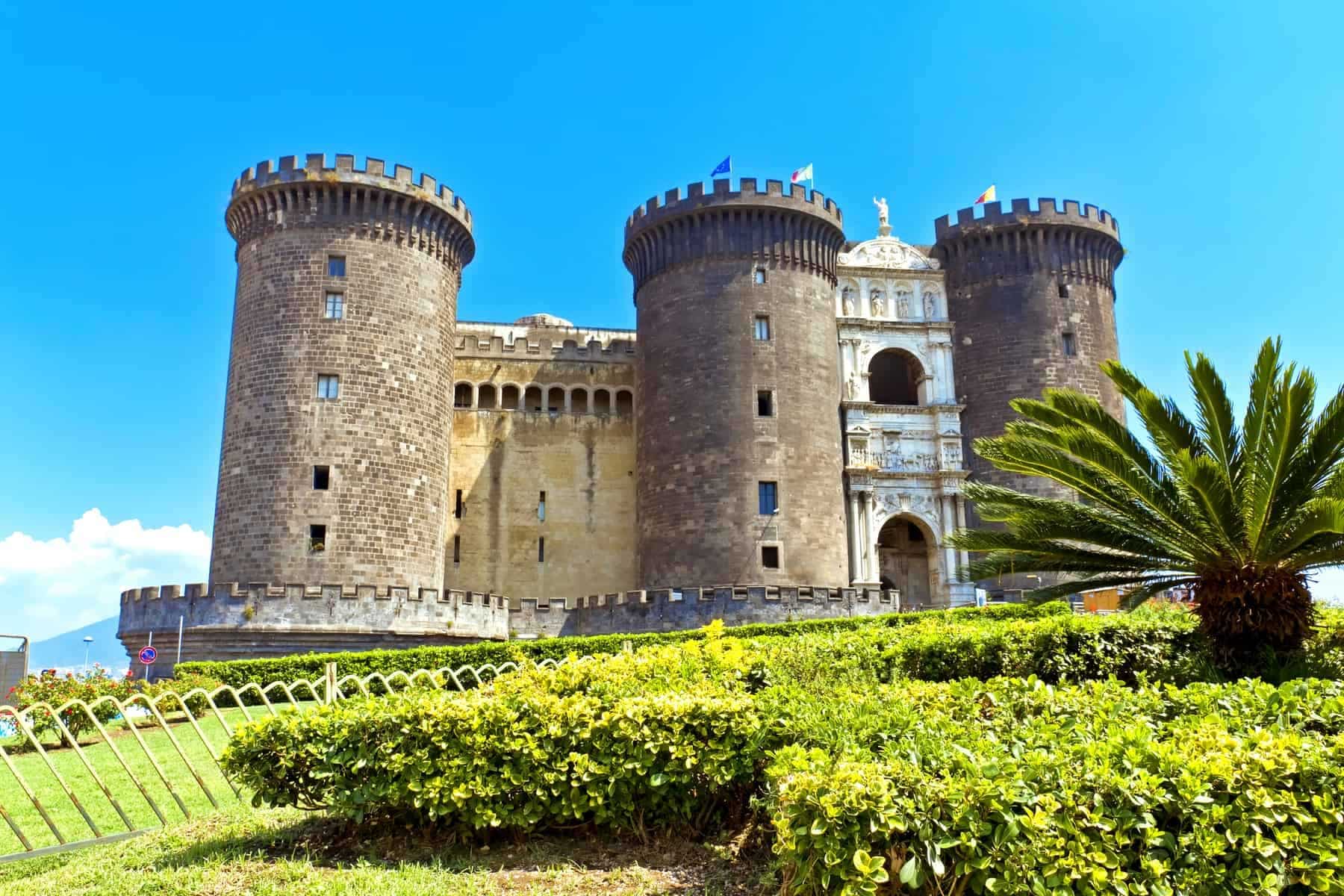
The medieval castle of Maschio Angioino or Castel Nuovo (New Castle), Naples, Italy.
Castel Nuovo
There are few places in Naples as recognizable like the Castel Nuovo in the heart of the Naples. This is a must visit, if you are into castles in Italy. The castle fortress was built when the French Angevins settled in the city to show their strength by constructing new monuments.
The castle was commissioned by King Charles I of Naples and entrusted the task of designing it to the architect Pierre de Chaules. It was launched in 1279 and completed in 1284. Due to the war, the new castle remained uninhabited until 1285, the year of Charles’s death. His son, Charles II, succeeded him. He was followed by his son Robert, who added Giotto’s decorations to the Palatinate chapel, which have now disappeared (the presence of the artist in Napoli is recorded between 1329 and 1331). When the Angevin kingdom was defeated by the Spanish Aragon family, the fortress was badly damaged. Alfonso of Aragon modified and restored the castle after his triumphant entry into the city. Testimony of this event is the magnificent triumphal arch at the entrance, one of the most prominent works of Renaissance art in southern Italy. Many architects and sculptors from all over Italy and Spain came to decorate the arch. It was a symbol of Aragonese power (Donatello was also called but he could not commit).
The castle housed the courtyard where the visiting royalty was and cultural dignitaries, such as Boccaccio, Petrarch and Giotto, who had decorated the room and the frescoed chapel, although only a few fragments of his work remain. It has been enlarged and adorned over the centuries, with a triumphal arch added to the sculptural splendor of the Renaissance, a contrast of white marble with heavy cylindrical towers. There was a protection ditch, and legend has it that one of the kings kept a crocodile there. The chapel is charming and the large Sala Grande, also known as Sala dei Baroni, has a spectacular vaulted ceiling 92 meters high (300 feet).
See the ancient ruins under the glass floors in Castel Nuovo
As you walk through the castle, you first enter the large courtyard. Going up the stairs, Baron’s Hall boasts vaulted domed ceilings and noble seating. The room bears this name because, in 1486, the barons conspired against King Ferdinand I of Aragon, but they were arrested in this space after being invited by the king to celebrate the wedding of his granddaughter. The room is still used for civic meetings.
Ancient ruins have also been discovered under the castle and you can walk through the Armory Hall where the floor is glass. Under your feet, you can see the rubble that could have been the pool of a Roman villa.
There is also a bronze door in the rooms on the upper floor of the Museo Civico, which still contains the integrated cannonball. This is the original gate of the castle dating from the 15th century, which was taken as war booty by the French then returned.
And finally, look for the mythical trap where Queen Jeanne II let her lovers be eaten by “sea monsters”, maybe crocodiles. Queen Joanna I also lived inside with Robert the Wise. Petrarch was there too.
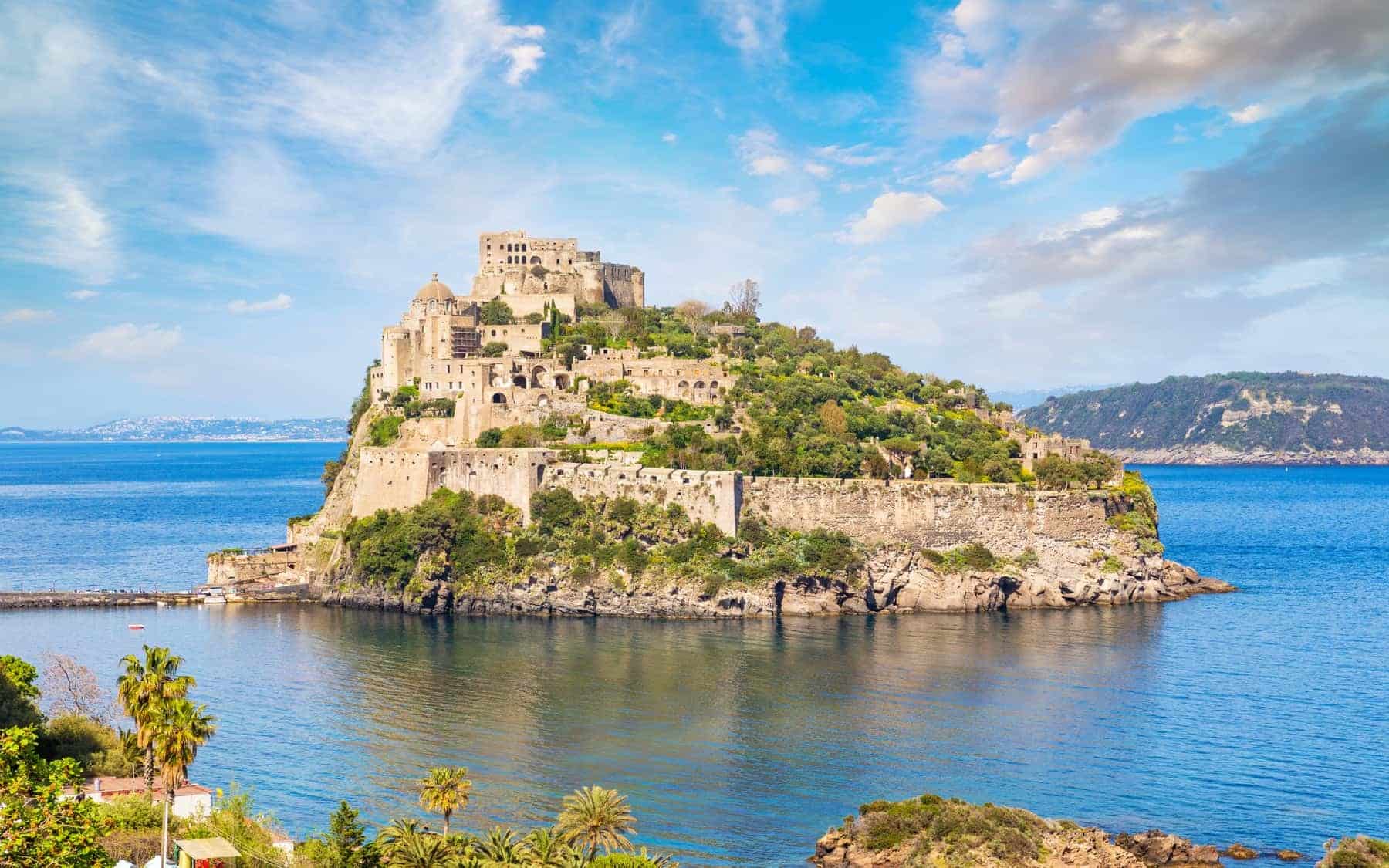
Aragonese Castle or Castello Aragonese is the most visited landmark and tourist destination near Ischia island, Italy.
Aragonese Castle, a different place, and very interesting on the list of castles in Italy
If you believe that castles are captivating, the Aragonese Castle of Ischia is even more mysterious, because it stands out from the sea, detached from the rest of the island. But it maintains an active link with the island, which goes beyond the bridge.
The castle was initially called Castrum Gironis: according to some extracts from the Girona (Hiero) of Syracuse (the first colony dating from the fifth century BC), according to the “round walls” fortified surrounding the trachytic rocky island.
In the Middle Ages, it was still called Insula Minor to distinguish it from Insula Major (the island of Ischia), which was gradually becoming populated.
It is at this time that goes up the current crypt of the cathedral Notre-Dame of the Assumption with its precious frescoes
Its current name (CHATEAU ARAGONAIS) originates from the dynasty that has most influenced the characteristic appearance of the island: Alphonse I of Aragon in the 15th century AD. The pre-existing Maschio Angiono, built with powerful defensive walls, has made it possible to dig a tunnel into the rock to allow pedestrian access.
You ascend by an elevator or a series of trails that will loop through the buildings and lush gardens. The marked route begins with the relatively modern and flat Chiesa dell’Immacolata, built-in 1737 on an old church. Commissioned by the Convento delle Clarisse (convent of the nuns Clarisse) neighbor, it was left in its minimalist state after the exhaustion of the funds allocated to the construction. Besides, the nuns contributed to the most bizarre and macabre view of the castle. When the old sisters died, their bodies were taken to the Cimitero delle Monache Clarisse without windows and without air, where they were propped on chairs in the shape of toilets seat. Living nuns had to pray every day for corpses in decomposition, a painful reminder of their own mortality. It is not surprising that many of them have been victims of diseases, sometimes fatal. The empty chairs remain visible in the cellars as a scary reminder.
The sun-drenched and stuccoed ruins of the 14th century Assunta Cathedral, which collapsed under cannon fire in 1809, were much brighter as the British attempted to bombard Napoleon’s occupying army. The 11th-century crypt beneath is home to fragments of 14th-century frescoes inspired by Giotto.
Continue until you reach the elegant and hexagonal Chiesa di San Pietro in Pantaniello and the dark Carcere Borbonico, former prison of personalities of the Risorgimento (Italian unification movement of the nineteenth century), such as Poerio, Pironti, Nusco and Settembrini. There is a small and terrifying Museo delle Torture, with a collection of medieval torture instruments and impressive armor and weapons.
Elsewhere, you can walk on the terraces of the castle, dive into various other small chapels and enjoy the view from the Terrazzo degli Ulivi (terrace of olive trees).

Doge’s Palace, top place on Castles in Italy you must visit
Doge’s Palace is one, if not the most impressive and easily recognizable buildings in Europe, the (Palazzo Ducale) serves as the center of the government of the Republic of Venice, and also the residence of the Doge. The first palace of the Doges was a miserable wooden fortress with huge defensive towers. After several fires, the castle was transformed into a Byzantine style palace. The one you see today was built in the 14th-century and the façade overlooking the Piazzetta dates from the 15th century. Although the palace is now a museum, unlike most museums, these paintings were created specially to decorate the Doge’s Palace, but were not added later. The works of art, the iconic beauty and the interesting history of the Doge’s Palace make it one of the main tourist attractions of Venice.
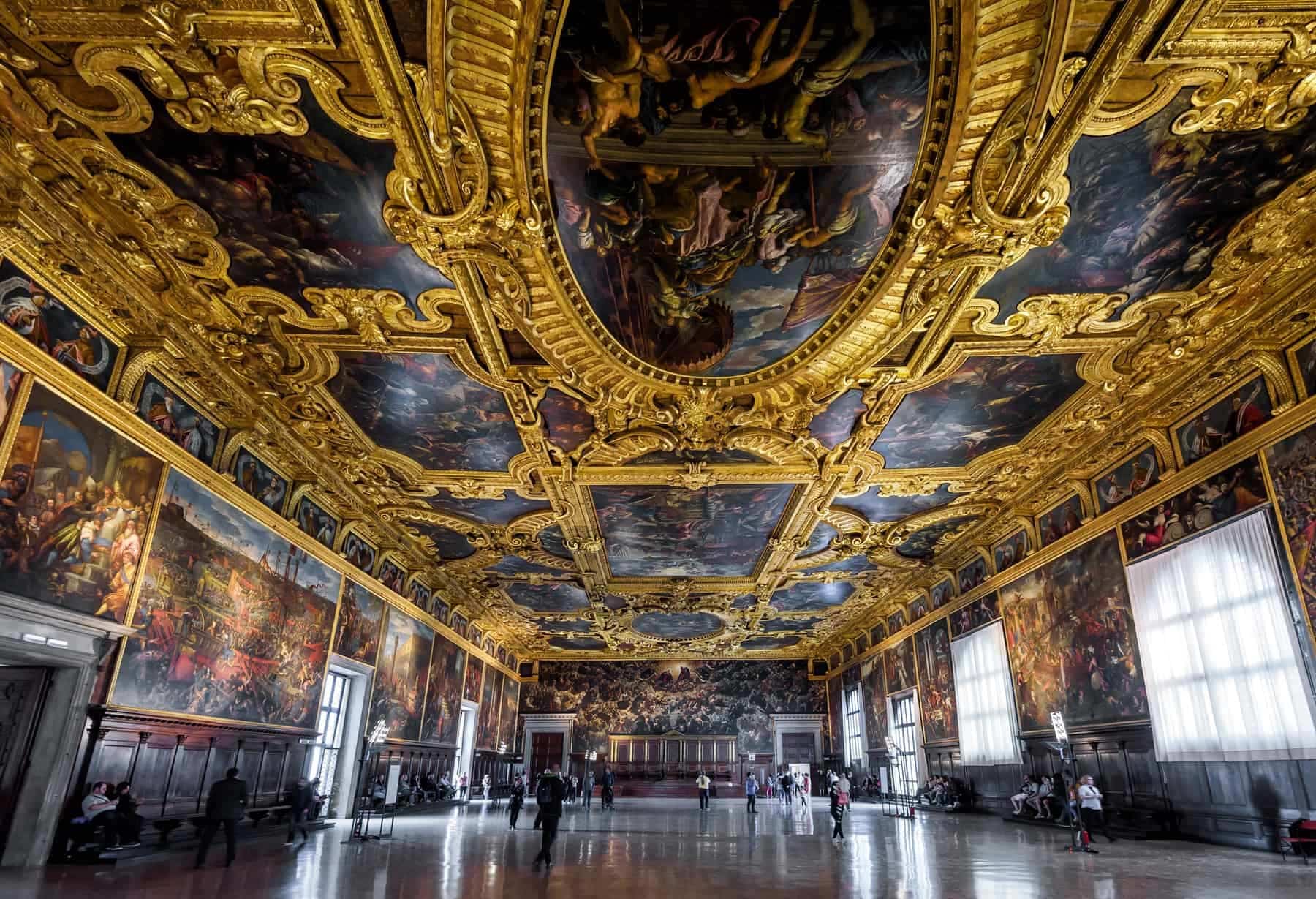
Interior of the Doge`s Palace (Palazzo Ducale), the Higher Council Hall. Doge`s Palace was built in 15th cent on St Mark`s Square and is one of the main tourist attractions of Venice.
The House of the Great Council (Sala del Maggior Consiglio)
This giant hall was the scene of a democracy before the letter. It is here that men belonging to the most important families of Venetian patricians decided the fate of the Republic. The Doge could have been the leader of Venice but without their approval, he could not decide anything. The hall of the grand council is decorated with frescoes of the first 76 doges, with the exception of Marin Faliero’s veiled black bust. This leader tried to get rid of the Council in 1355. This not only led to the death penalty, but was also condemned to “damnatio memoriae”; the complete eradication of his memory from history.
Courtrooms (Sala del Magistrato alle Leggi)
Unlike most of Italy, which was subordinated to the Roman judicial system, Venice could decide its own legislation. As a result, their trading system would flourish. The Doge’s Palace not only served as the Doge’s room, but where laws were established and obeyed. In this room there is also a beautiful triptych by Hieronymus Bosch.
The rooms of the doge (Appartamento Ducale)
Although he was considered the supreme leader of the Republic, he was also minister of the state. That’s why his private rooms in the palace are surprisingly small and modest. The visual appeal here is the sanctuary, where you can see a collection of terrain maps that shows how vast the Republic of Venice was. In addition, there are also some beautiful paintings and two giant world globes that show the worldview of the 18th century.
The Armory (Armeria di Palazzo)
To secure its dominance on maritime trade routes, it was necessary to have the necessary weapons to dissuade her opponents. The Venetian army was available at any time to thwart a possible attack. Most of the weapons depots here have been manufactured at Arsenal, which is also worth a visit. In addition, you can find swords, crossbows and harnesses, but also the “devil’s chest”. It’s a real trap where four guns and poisoned arrows were fired at the unfortunate woman who opened this chest.
The secret rooms (Stanze segrete)
This name was given to several halls in which very secret and often dark events took place … These are mainly interrogation rooms and cells. These are composed of pozzi (small damp rooms for ordinary criminals) and piombi (cells a little more comfortable for more “virgin” prisoners). It is from one of these piombi that the famous seducer Casanova managed to escape. The secret rooms also contain a torture room where the Venetians obtain confessions from the prisoners by using a noose.
The new prison and the bridge of sighs (Prigione Nuovo and Ponte dei Sospiri)
In the seventeenth century, Antonio da Ponte, the architect of the Rialto Bridge, decided to move the prison cells of the Doge’s Palace into an adjacent building on the other side of the canal. In order to connect this house to the interrogation rooms, he ordered his nephew Antonio Contino to design the bridge of sighs. A few centuries later, this bridge has become one of the most famous bridges in the world because of its dark name. The prisoners could have a last glimpse of the outside world and only sigh …
Places to see in Italy
Calabria, one of the most beautiful regions of Southern Italy
Sicily from Etna’s volcanic landscape to dazzling white beaches to the south
Italian dishes from the classical Italian cuisine
Famous castles in Europe
More than 50 selected castles you can visit in Europe. Pick 10?
- 10 majestic castles in Germany
- Famous castles in England, including Windsor, Dover, Highclere
- Highclere and Downton Abbey, the series and now the film
- Scotland and its huge selection of austere, impressive or fairytale like castles
- Most amazing castles in France including Versailles
- Castles in Italy from north to south




